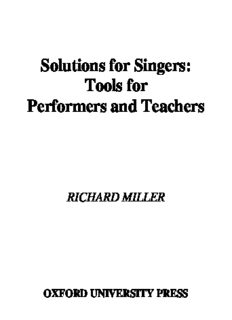
Solutions for Singers: Tools for Performers and Teachers PDF
Preview Solutions for Singers: Tools for Performers and Teachers
Solutions for Singers: Tools for Performers and Teachers RICHARD MILLER OXFORD UNIVERSITY PRESS SOLUTIONS FOR SINGERS This page intentionally left blank SOLUTIONS < FOR = SINGERS Tools for Performers and Teachers RICHARD MILLER 1 2004 1 Oxford New York Auckland Bangkok Buenos Aires Cape Town Chennai Dar es Salaam Delhi Hong Kong Istanbul Karachi Kolkata Kuala Lumpur Madrid Melbourne Mexico City Mumbai Nairobi São Paulo Shanghai Taipei Tokyo Toronto Copyright ©2004 by Oxford University Press,Inc. Published by Oxford University Press,Inc. 198 Madison Avenue,New York,New York,10016 www.oup.com Oxford is a registered trademark of Oxford University Press All rights reserved. No part of this publication may be reproduced, stored in a retrieval system,or transmitted,in any form or by any means, electronic,mechanical,photocopying,recording,or otherwise, without the prior permission of Oxford University Press. Library of Congress Cataloging-in-Publication Data Miller,Richard,1926– Solutions for singers:tools for performers and teachers / Richard Miller. p. cm. Includes bibliographical references and index. Contents:pt. 1. Breath management—pt. 2. Posture—pt. 3. Laryngeal and intra-laryngeal function—pt. 4. Resonance balancing. ISBN 0-19-516005-3 1. Singing—Questions and answers. 2. Singing—Instruction and study. I. Title. MT820.M5993 2003 783(cid:1).04—dc21 2002041661 1 3 5 7 9 8 6 4 2 Printed in the United States of America on acid-free paper In Memoriam William McIver This page intentionally left blank ACKNOWLEDGMENTS I wish to thank my friends and colleagues Carol Sedgwick,D.M.A.,and Shirley Zielinski,Ph.D.,for reading manuscript drafts and offering me sensible advice. Ad- ditional thanks are due final-draft peer evaluators, unknown to me, whose com- ments were exceedingly helpful. I am grateful to members of the editing and pro- duction staff of Oxford University Press for their ready assistance. To Richard Sjoerdsma,editor of Journal of Singing,my thanks for permission to rework some items I have previously touched on in a regularly contributed sotto vocecolumn for that journal. My biggest debt is owed Mary,my wife,who continues to be my guiding light in this,as in all ventures. This page intentionally left blank PREFACE Over several decades it has been my privilege to meet with singers and teachers in weeklong courses devoted to the art of singing,in which the correspondence of ef- ficient physiologic and acoustic function to artistic expression is considered in de- tail. Half of each day is devoted to systematic technique,the remainder to master classes in communication. Several thousand teachers, students, and professional singers have participated. To ensure sequential information,and to avoid interrup- tion of master class performances, observers are asked to write out questions as they occur to them. Questions are then codified and discussed in question-and- answer sessions at the close of the week. These inquiries often go to the heart of vocal pedagogy,pointing out watersheds that separate voice-training systems. This book deals with a number of them—some briefly,some in detail. Recurring topics have been selected from more than fifteen hundred written questions. They deal with both technique and artistry. Falling into specific cate- gories,they consider a single topic from several angles. I have tried to tailor my responses to the specifics of each question. Associated issues are assembled within overall categories; related questions have been joined together. Technical areas considered involve breath coordination,laryngeal function,resonator-tract response, resonance balancing, voice categorization, voice registration, linguistic articula- tion,vibrancy,matters of style,the enhancement of artistry and communication, pedagogic and professional attitudes and concerns,and healthy voice production. In answering variations on similar themes,for clarity and completeness,it has oc- casionally been necessary to revisit important facets of information.
Description: